Radio Control Pylon Racing
Turn Left — and Fly Fast!
The Sanderson Field RC Flyers (SFRCF) hosted a sanctioned Academy of Model Aeronautics (AMA) pylon competition on September 6 & 7, 2008. The competition was sponsored and organized by the Pylon Racers of Puget Sound (PROPS). The event was held at the SFRCF home field in Shelton, Washington.
In addition to hosting the event, some of the SFRCF club members served as course judges, timers, lap counters, and fueling station supervisor. Other members managed a food service for both pilots and course workers.
Although the actual racing began on Saturday, September 6, the pilots actually arrived on Friday for registration. During registration, all aircraft underwent a safety inspection, as outlined in the AMA's Competition Regulations.
The Race Course
On Friday, the event organizers also set up the race course (Figure 1) and associated equipment. Ten laps around the course equaled 2.5 miles. Pilots flew their aircraft around the course in a counterclockwise direction. The course length was selected to result in 10-lap times between one minute (fast pace) and two minutes (slow pace for beginners). The 10-lap times for the races on Saturday and Sunday fell within this range. For the quickest aircraft, the speed around the course was between 180-200mph.

The race course was defined by three pylons. Each pylon was 20 feet high. Pylon-1 was positioned at one end of the course near a signal board (Figure 2) containing red lights to signal when a pilot's aircraft "broke the gate." The "gate" was a line from pylon-1 to the flaggers position not less than 300 feet away. A pilot seeing his signal knew that he could make his turn at pylon-1 without "cutting." Two white lights on the board were also lit for a pilot in the event of a "cut" (a turn on the inside of a pylon). The lights were controlled by the flaggers.
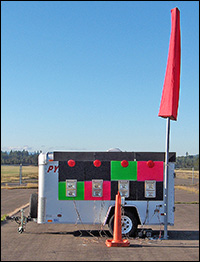
As can be seen from the figure above, there were four lane designations: lower green (lane 1), lower red (lane 2), upper green (lane 3), and upper red (lane 4). Each pilot identified his/her aircraft with a press-apply decal corresponding to an assigned lane. More on this later in the article.
The start/finish line was positioned 508 feet from Pylon #1 down the center of the course and 100 feet from a line connecting pylons #2 and #3. Pylons #2 and #3 were separated by 100 feet and formed the end of the triangular course.
Course Workers Arrive
Club volunteers began arriving at the field at 8:00AM. Initially, members grouped themselves around Bob Beatty until Chuck Kentfield pointed out where the coffee and donuts were located. The volunteers, led by Stacy Myers, then moved the assembly point closer to the food supply (Figure 3).
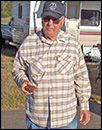
After coffee and donuts, the crew set up the tent for the food service (Figure 4).
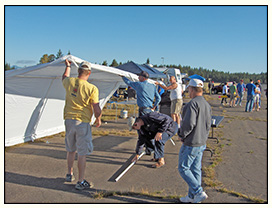
Pilots, Prepare Your Aircraft
Before the races began, the pilots performed last minute checks on their aircraft (Figure 5).
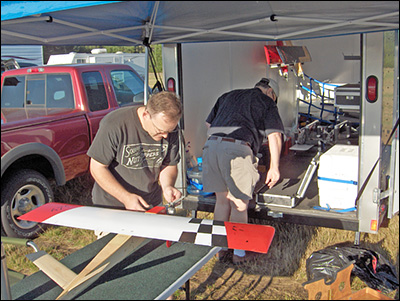
Before each heat, pilots fueled their aircraft (Figure 6) and applied a colored decal to the aircraft's wing.
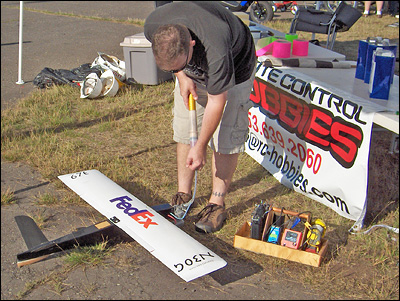
Stacy Myers supervised the fueling station throughout the competition. This also included weighing the heat-winning aircraft to insure that they were not lighter than the AMA's minimum weight requirements (Figure 7).
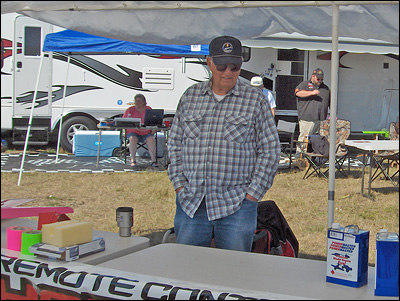
Pilots applied a decal according to their assigned starting-lane position for a heat (see Figure 9):
- Lane-1, green decal on the low end of the wing,
- Lane-2, red decal on the low end of the wing,
- Lane-3, green decal on the high end of the wing, and
- Lane-4, red decal on the high end of the wing
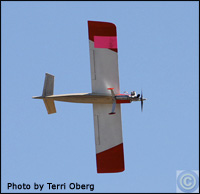
If you visualize an aircraft in front of you during a sharp left hand bank away from you and around a pylon, one end of the wing will be higher than the other. Aircraft in Lane 1 or 2 have a decal on the low end of the wing; aircraft in Lane 3 or 4 have a decal on the high end of the wing. Figure 8 shows a lane-4 aircraft (high red) banking for a turn.
Course judges used the decals to identify each aircraft. For example, a "Cut Judge" might have reported a cut like this, "Cut on high red."
Figure 9 shows a pilot applying a Lane-3 decal (high green). The color designations were also repeated on the signal board shown earlier (Figure 2): there were both low and high green and red colored rectangles painted on the board to designate the signal lights for each lane.
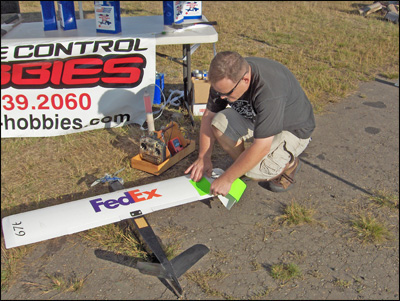
The Racing Begins
After a short meeting, the course workers occupied their work stations. These included stations for pylon 1-3 cut judges, fueling station, flaggers, and timers/lap counters. For safety, all stations were positioned at least 300 feet away from the race course and both pilots and course workers wore hard hats.
At the same time, the pilots, with their aircraft and callers, were driven to the starting line (Figure 10).
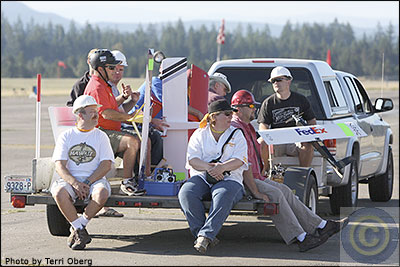
When the pilots were positioned at the start/finish line, a 60-second timer was started (Figure 11). Pilots had one minute to start their engines and prepare for takeoff.

Pilots were prepared for takeoff when their engines were started and they were facing pylon #1 with both hands on the radio transmitter. Pilots not prepared for takeoff before the timer ran out were disqualified for the heat. As soon as all pilots were in position and ready to control their aircraft, the starter gave the signal to launch, and the heat began (Figure 11-2).

During the race, the pilot's partner, the caller, was of critical assistance to the pilot. In addition to launching the aircraft, and because the pilot's attention was so focused on controlling his/her aircraft, the caller determined when the pilot should commence a turn around a pylon and called this out to the pilot. Pilot and caller teams typically have long-time associations, and are often family members.
Cut judges were assigned to each pylon in order to insure that the aircraft turned outside the pylons instead of "cutting" inside a pylon during a turn (Figure 12). One "cut" required an extra lap around the course for a pilot's aircraft; two "cuts" disqualified the pilot's aircraft from the heat.
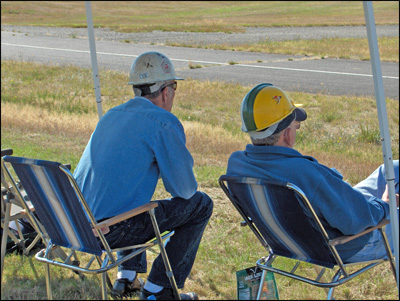
Lunch Time
Each day, volunteers from SFRCF provided a great meal service (Figure 13).
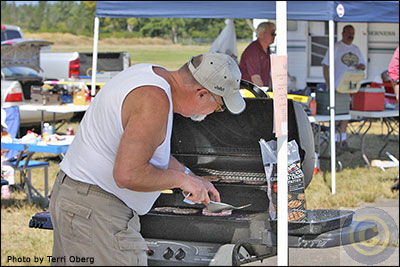
After lunch, there was plenty of time to look at the aircraft and meet the pilots (Figure 14):
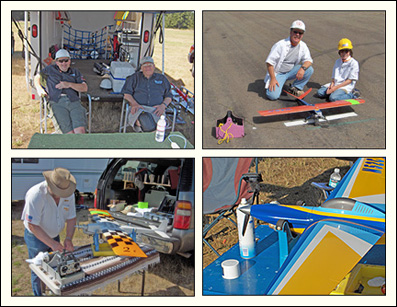
Prizes & Awards
After the last race, both pilots and course workers returned from the field (Figure 15).

Everyone collected near the fueling station for the prize drawing and the awards ceremony (Figure 16-20). Prizes for the course workers were donated by RC Hobbies of Olympia and Covington, WA.
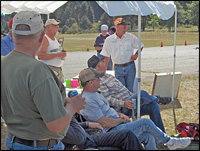
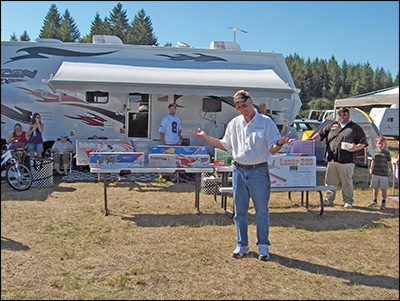
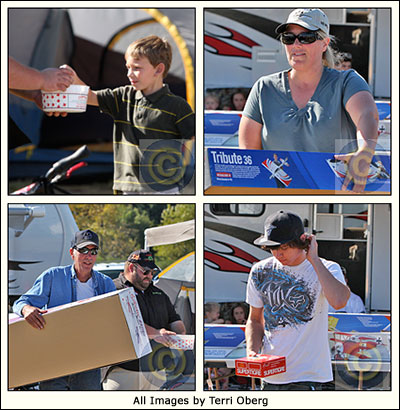
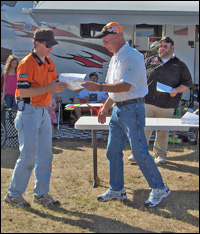
The awards ceremony ended the day for the SFRCF volunteers, except for those removing the tent and equipment used for the food service(Figure 20).
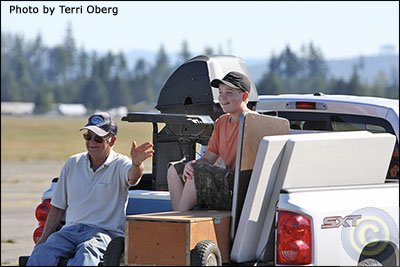
By the end of Monday, the PROPS organizers had removed the race equipment and cleaned the field, except for some traces of crashed aircraft (Figure 21).
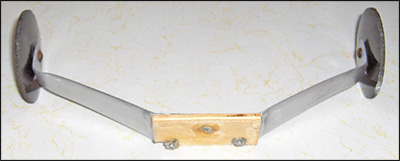
Thanks to All SFRCF Volunteers:
Dave Fisher, Stacy Myers, Jody Diaz, Burt Daggett, Sharon Diaz, Cameron Diaz, Bob Beatty, Royce Tivel, Bob Treinen, Chuck Kentfield, Bob Mason, Georgene Mason, Eric Oberg, Bill Asmus, John Tupper, Jan Tupper, Gordon Osberg, Bob Andrew, Bonnie Beatty.
Appreciation for the job these volunteers did throughout the event was universally expressed by all participants. Thanks also to any volunteer whose name is missing from the list.
Special thanks to Terri Oberg for allowing the use of many of her images for this article. They really help tell the story.
Thanks to All of the PROPS Organizers an Volunteers
Thanks to all of the PROPS organizers for bringing the pylon event to Shelton. The organizers included Eric Ide - PROPS President, Tom Strom Sr. - Contest Director, and Dan Nalley - Equipment Coordinator. Many other non-SFRCF volunteers worked the course, especially at the flaggers station.Thanks are due to them as well.
Notes:
It is now 2020. It has been many years since there has been a pylon race at Sanderson Field. The pylon events were a thrill to watch and were great spectator events—particularly for me, a novice just getting started in RC. In 2008, many of the pilots were national contenders and Tom Strom Sr. was a national record holder. I, for one, am sad that they no longer take place at our field. Most of the photographs were taken with a camera that was really not up to the task. It would have been a pleasure to photograph the events with my more modern SLR camera.